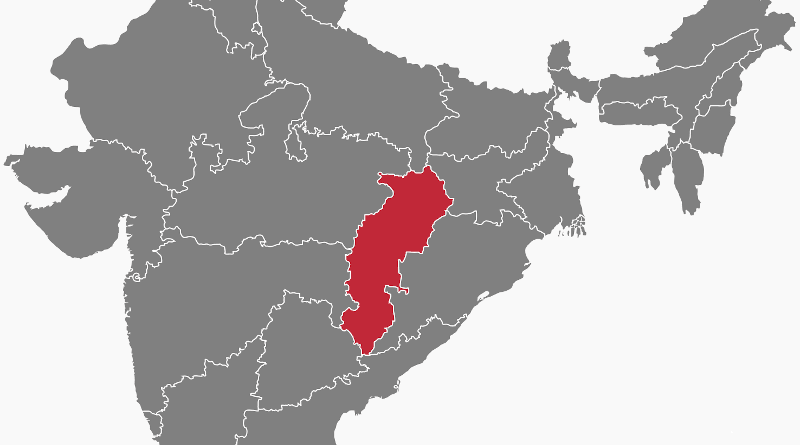India: Ineffective Red Revival – Analysis
By SATP
By Deepak Kumar Nayak
On August 30-31, 2023, Communist Party of India-Maoist (CPI-Maoist) cadres killed a policeman, Budhram Avalam, slitting his throat in Duvalipara village under Gangaloor Police Station limits in the Bijapur District of Chhattisgarh.
Assistant Superintendent of Police (ASP) Chandrakant Gowarna, confirming the incident, disclosed, “The deceased constable Budhram Avalam was on leave and went to his home village, Jangla. On Wednesday (August 30), he went to Gangaloor to drop off his nephew on a motorcycle. While returning from there, Maoists ambushed him and then abducted him. The Maoists then killed him in the forest and threw his body on the road. The villagers recovered the body on August 31 and informed the Gangaloor police. On receiving the information, the police team reached the spot and took the body into their possession.”
On August 15, 2023, two Jharkhand Jaguar Force personnel, Sub-Inspector Amit Tiwari and Constable Gautam Kumar, were killed by Maoists in a forest area between Tumbahaka and Sarjomburu villages under Tonto Police Station limits in the West Singhbhum District of Jharkhand. The policemen were killed when the Maoists opened fire on a joint team of the Security Forces (SFs) which had launched a search operation in the area. Though the SFs retaliated, no Maoist casualty was reported.
On August 11, 2023, one Central Reserve Police Force (CRPF) trooper was killed and another was injured when the Maoists opened fire in a forest in the Tonto area near Husipi village under Goilkera Police Station limits in the West Singhbhum District of Jharkhand.
According to partial data collated by the South Asia Terrorism Portal (SATP), at least 23 SF personnel have lost their lives while fighting the Naxalites(Left Wing Extremists) in the current year, so far (data till September 3). On the other hand, the SFs have killed 37 Naxalites, yielding a SF:Maoist kill ratio of 1:1.6 in the current year. During the corresponding period in 2022, this ratio stood at 1:3.25 (12 SF personnel, 39 Naxalites killed). Through 2022, this ratio worked out at 1:4.46.
A closer look at the data suggests that, though the SFs have maintained a positive kill ratio since 2011, the 2023 ratio is the worst (from the SF perspective) since 2014. The SF: Maoist kill ratio was 1:1.26 in 2014, 1:1.96 in 2015, 1:4.03 in 2016, 1:2 in 2017, 1:3.16 in 2018, 1:2.8 in 2019, 1:3.04 in 2020, 1:2.5 in 2021. Since 2000, the SF:Maoist kill ratio has been in favor of the Maoists only thrice: 2007 (1.2:1); 2009 (1.01:1); and 2010(1.007:1). The overall kill ratio, since March 6, 2000, when SATP started compiling data on Left Wing Extremism (LWE) in India, stands in favor of the SFs at 1:1.61.
In terms of absolute numbers, the SF personnel killed in 2023 (23) has already crossed the total for 2022 (15), with almost four months still to go in the current year. The 2022 SF tally was the lowest in a year since 2000, when there were 40 fatalities in this category.
Though the kind of losses the Maoists have suffered over the years and the SF consolidation on the ground, make their task of a rebel revival quite difficult, the 2023 SF:Maoist kill ratio may raise Maoist morale. On August 1, 2023, Union Minister of State for Home Nityanand Rai informed the Lok Sabha (Lower house of Parliament) that LWE-linked violent incidents and resultant deaths across the country had reduced by 77 percent and 90 per cent, respectively, in 2022 as compared with 2010. The improved scenario was also reflected in the number of districts reporting violence, which had dropped from 96 in 2010 to 45 in 2022.
Indeed, as SAIR noted earlier, in their effort to revive their failing movement, the Maoists have increased their crusade against assumed ‘police informers’, and have acted harshly to eliminate purported ‘infiltrators’ or ‘emissaries’. Their increased brutality is reflected in at least nine incidents of hacking and throat-slitting in 2023, compared to six such incidents through 2022. A total of 40 civilians have already been killed in the current year, in addition to 52 in 2022.
Meanwhile, the Maoists have triggered at least 39 blasts, killed at least 21 persons, and injured another 37 in 2023, compared to 32 such explosions, which killed at least six persons and injured another 27, through 2022. The Maoists carried out one rocket attack in 2023, while no such incident was recorded in 2022. The last such incident was recorded in 2019, when around 100 Maoists used light machine guns (LMG) and rocket launchers in retaliation against a joint operation launched by SFs in the Maniyara Forest area, along the borders of Munger and Lakhisarai Districts in Bihar, on October 13, 2019.
On August 2-3, 2023, the CPI-Maoist organised a massive public meeting on the borders of Dandakaranya and Telangana as part of the Maoist ‘Martyrs Week’, from July 28 to August 3. In a statement released to the media in the Bhadradri Kothagudem District of Telangana on August 5, Maoist Telangana State Committee ‘spokesperson’ Jagan and Dakshin Bastar Division Committee ‘secretary’ Gangal declared that people from three panchayats (village level local self-government institutions) of the ‘Janatana Sarkar’ (people’s government of the Maoists) participated in the meeting ‘voluntarily’. A memorial built in honour of deceased Maoist leader Katakam Sudarshan aka Anand, was inaugurated during the meeting. Cultural programmes by Chaitanya Natya Manch (CNM) and Jana Natya Mandali (JNM), cultural wings of the Maoists, were organised for two days. The families of Maoist ‘martyrs’ were introduced to the public.
The Maoists have been battered in their areas of erstwhile dominance, but remain committed to their purpose, making dogged efforts to stage a revival. Sustained SF pressure must deny even symbolic victories to the rebels, even as the SFs continue to consolidate the gains of the past years.
- Deepak Kumar Nayak
Research Associate, Institute for Conflict Management

